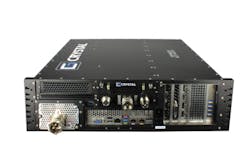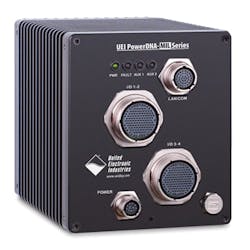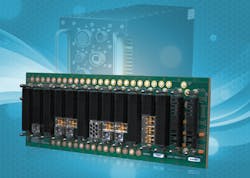The growing need for usable information in the field is influencing the selection of bus and board architectures for new and upgraded aerospace and defense system designs.
Aerospace and defense personnel, like most people today, depend on data. Information is integral to the success of a broad array of military and aerospace projects, missions, and battles. Even wars, it is said, are in- creasingly fought with bits and bytes.
Computer, electronics, and avionics system designs today, therefore, center on providing secure, reliable access to usable data. Yet, as engineers work to upgrade and modernize systems across domains - land, sea, air, space, cyber, and the electromagnetic spectrum - they are confronted with interoperability, connectivity, bandwidth, and security challenges.
Convergence conundrum
Aerospace and defense applications rely on data, often in real time or as near to it as possible, which puts a premium on robust, high-speed, connected systems and devices.
"The very high speed of the newest technologies makes signal integrity from end-to-end very important. One can no longer just plug things together and know they are going to work," says Michael Munroe, technical standards specialist at Elma Electronic Inc. in Horsham, Pa. In fact, "the biggest technical challenge we see is board interoperability, even when all are compliant to industry specifications."
Elma engineers are bringing the company's chassis and backplanes to bear on U.S. military system convergence challenges. "The effort is to combine what used to be multiple boxes of a total system (vehicle) into one box. This brings the former box-to-box communication onto the Elma backplane at the same time that data bus speeds are being increased," says Munroe, who finds it interesting and rewarding to help troubleshoot and sort out technical challenges.
Making the connection
The need for speed is influencing interconnect decisions throughout aerospace and defense designs, at the board, chassis, and system levels.
High-speed serial links are replacing virtually any bus, explains Rodger Hosking, vice president of Pentek Inc. in Upper Saddle River, N.J. "Gone are the parallel bus architectures previously used to interconnect virtually all embedded system elements. This not only applies to devices on the same boards but also between boards and systems.
"The benefits of fewer lines, less real estate, and smaller connectors are often well worth the added design challenges of higher bit rates and more sophisticated interfaces," says Hosking, who is witnessing a move from copper to optical connections.
"Spurred by the shift from parallel to serial links, optical interfaces are especially attractive for delivering high-bandwidth data over longer distances and where cable size, weight, and signal integrity are critical," Hosking continues. In fact, engineers are on the hunt for products capable of handling higher signal frequencies and bandwidths for their software radio communications and radar systems.
"Most new high-bandwidth A/D and D/A converters have abandoned simple parallel low-voltage differential signaling (LVDS) interfaces in favor of more complex JESD204B gigabit serial links, invariably implemented with custom field-programmable gate array (FPGA) engines," Hosking explains. "Not only must the FPGA accommodate the complexity of the JESD204B interface, but it must also handle data rates up to 9.6 gigabytes per second. As the sampling rates and operating modes change, these interfaces must adapt accordingly, further complicating the tasks."
Pentek's solution to the challenge lies it its Model 71141 6.4 gigasample-per-second A/D and D/A XMC module, the latest member of its Jade architecture for Xilinx Kintex UltraScale FPGAs. "By incorporating the required circuitry within the FPGA as an optimized and factory-installed intellectual property (IP) core, Model 71141 is ready to use, saving customers from tedious FPGA design tasks," Hosking says. Pentek's Navigator Design Suite offers libraries and drivers for application development, and an optional FPGA development kit for adding custom IP.
Interface with Ethernet
"We've seen an explosion in the number of military and aerospace systems that count on the Ethernet as the primary controlling interface between their central processing units (CPUs) and their input/output (I/O)," says Bob Judd, director of business development at United Electronic Industries (UEI) in Walpole, Mass. Judd cites a few reasons the Ethernet has become so popular, but perhaps the most powerful of is long operational lifespan.
"The Ethernet will be here for a long time. PC technology may change - e.g., Peripheral Component Interconnect (PCI) migrated to PCI Express - but the new revisions of Ethernet remain backward compatible," Judd explains. "That's critical in applications where the lifetime of a product needs to be measured in decades, not years or quarters.
"As PC technology changes and older CPUs become obsolete," Judd says, "it's critical that new, modern CPUs can be brought on line that can use the existing infrastructure. The Ethernet provides this bridge between existing systems and the next generation of computers."
Open architecture adoption
Aerospace and defense applications are moving to open-architecture electronic designs for reasons of cost, interoperability, and simplified integration, upgrades, and maintenance.
VPX (VITA 46) is gaining design wins in many data-intensive applications where throughput and high-compute density (size) are critical factors, including signal and video processing, radar, communications, transportation, control, and management.
VPX adoption is rising rapidly for a wide range of systems, largely due to its dense, high-bandwidth backplane interconnects and its ruggedness, says Mark Littlefield, vertical product manager for defense at Kontron America Inc. in Poway, Calif. "The wide adoption of 10 Gigabit Ethernet is also a driving force making VPX a popular board architecture."
New applications sometimes also require additions to industry standards. "As new applications for VPX emerge, new requirements sometimes mean that new profiles must be defined to help guide the interoperability points necessary for integrating module to module, module to backplane, and chassis," says Jerry Gipper, executive director of the VITA open standards and open markets industry trade association in Oklahoma City. "OpenVPX will continue to evolve and incorporate new fabric, connector, and system technologies."
"OpenVPX is by far the hottest architecture trend," Elma's Munroe says. Sensor Open Systems Archi-tecture (SOSA), the new standards group effort started by Dr. Ilya Lipkin by the U.S. Air Force, ties in command, control, communications, computers, intelligence, surveillance, and reconnaissance/electronic warfare modular open suite of standards (CMOSS) activities begun under the U.S. Army's Communications-Electronics Research, Development and Engineering Center (CERDEC). "SOSA defines the open hardware platforms for next-generation vehicle systems, and is based on the OpenVPX architecture."
"The VPX market has matured over the years and somewhat settled down with respect to architectures, largely due to VITA 65/OpenVPX," says Kontron's Littlefield. Yet, "there is still a lot of variability in VPX implementations, and both interoperability and interchangeability continue to be issues." Attacking those challenges are standards working groups for Modular Open Radio Frequency Architecture (MORA), Future Airborne Capability Environment (FACE), Sensor Open Systems Architecture (SOSA), and Hardware Open System Technology (HOST)/VITA 84, he says. "It's not simply a matter of pin grabs and slot profiles; it also involves things like system design approaches and software stacks."
Littlefield credits the industry working groups with driving things from a functional standpoint, "solving problems in determining what components best solve design issues/requirements and how these components are configured. The functionality is much more complex than in the '80s and '90s when VME (Versa Module Europa) ruled, and these groups are doing a great job defining these functional elements."
Standing the test of time
Computer on Module (COM) Express is gaining traction in a wide range of defense and avionics applications, and becoming a strong player, Littlefield says. "While one may not immediately think of COM Express as a reliable deployable form factor for aerospace and defense systems, we are seeing it applied to systems in ground vehicles, commercial and military fixed-wing aircraft, helicopters, and unmanned aerial vehicles (UAVs)," he says. "The only place I haven't seen it applied is spacecraft, but it's probably just a matter of time.
"Stick to industry standards and design practices; don't try to be too inventive in your system design approach," Littlefield recommends. "The more you stray from the norm, the harder and more expensive it will be to find the solution components that you need to build your deployable system.
"Sometimes in order to meet your mission requirements, you should approach a problem in an innovative way, which forces what might be seen as an unconventional system design," Littlefield continues "Even in these cases, it is best to try to employ common design patterns. Otherwise, you will end up with an expensive, custom solution and future tech refreshes will be all but impossible."
Think long term, UEI's Judd advises. "What you design today will probably still be running in 30 years. It may not be that you have to support it, but somebody will. A 10 or 20 percent savings in the development cost or delivery price of the system today is not cost-effective if the system becomes impossible to support or maintain in 10 years. The more you think about the long-term ramifications of the systems you develop, the better off your company and your customers will be."
Built-in security
"The military and aerospace world doesn't treat the Internet of Things (IoT) the same as typical commercial IoT applications because of security concerns," says Bob Judd, director of business development at United Electronic Industries (UEI) in Walpole, Mass. Nonetheless, he says, demand for smaller, localized IoT applications is on the rise. For example, a U.S. Navy ship design might not store data on an Internet-based Cloud, but may use a local Cloud host on-board from which data can be made available to computers and subsystems ship-wide.
"Even on captive, local networks on a ship, aircraft, or ground installation, the military is beginning to demand encryption. It's moving from a 'nice to have' feature to one that will soon be a firm requirement," Judd continues. "It has not risen to the level of biggest challenge yet, but data and system security issues may jump into first place in the not-too-distant future.
"In the military world, security aspects are rapidly becoming paramount; even in commercial aviation, system designers are very concerned about unauthorized access to data or, even worse, possible hacking of control systems," Judd adds. UEI is releasing a new version of its CPU modules with built-in hardware encryption to provide the security new systems will demand, but without the performance penalty of commonly used software-based encryption algorithms, he says.
For more on IoT technologies in aerospace and defense, visit http://bit.ly/2iXNfst.
Safety-certifiable COTS
The use of commercial off-the-shelf (COTS) technologies for aerospace and defense applications has moved into the safety-critical realm. Engineers are eager to leverage COTS modules to support safety-critical applications to RTCA DO-178 Software Considerations in Airborne Systems and Equipment Certification and DO-254 Design Assurance Guidance for Airborne Electronic Hardware Design Assurance Level (DAL) C and higher, and meet the need for mixed assurance graphics.
Interest in certifiable COTS modules continues to grow, says Greg Tiedemann, product line director of Mercury Mission Systems in Phoenix. Aerospace and defense engineers across a wide range of applications are interested in Mercury's safety-critical COTS product line, he says.
"The interest is fueled by the constraints on budget and schedule that doesn't allow for custom developments, as has been the case in the past," Tiedemann says. "We are seeing multiple applications for high-definition (HD) video streaming to cockpit displays and around the aircraft," Tiedemann explains. The trend toward glass upgrades in aircraft cockpits is driving the demand for mixed safety assurance graphics, and has generated some distinct challenges, he says.
Mercury was selected to provide safety-critical video server subsystems, which will perform encoding/decoding and switch multiple HD video streams, for a military airborne platform. "The challenge is always to provide a mix of boards at different safety-critical levels, within a single Modular Open Systems Architecture that can be easily configured for different sensors and upgraded for future capabilities," Tiedemann says.
Mercury engineers leverage a large portfolio of safety-certifiable processing and I/O building blocks and pre-integrate them into adaptable, pre-engineered avionics chassis, he says. For example, the company's ROCK pre-engineered, safety-certifiable chassis features multiple safety zones that support mixed assurance graphics and other applications requiring more than one level of safety certification.
Mercury personnel are also integrating safety-certifiable graphics libraries from Richland Technologies, an automotive and defense safety company it acquired, into the Mercury portfolio to expand its video server capabilities and safety-certifiable COTS offerings. Automotive electronics and software technologies are advancing rapidly in response to increased investment by top technology leaders, particularly in autonomous vehicles like self-driving or driverless cars. "Increased demand for automotive safety capabilities is influencing defense applications," Tiedemann explains. "The investment in Richland enables Mercury to integrate automotive technology for certifiable processing and graphics technologies into defense applications."
Technology transfer is growing among the automotive, Internet of Things (IoT), and aerospace/defense communities. Read more online about autonomous vehicle and IoT hardware and software innovations applicable to aerospace and defense applications from defense suppliers, such as Wind River, Crystal Group, and others at http://bit.ly/2eXAidS.
Speed time to market
Save time by buying one or more development systems before trying to build a deployable system, recommends Michael Munroe, technical standards specialist at Elma Electronic Inc. in Horsham, Pa. "A development system can prove feasibility, allow software work to start sooner, and be a critical support tool for deployable systems in the future."
Rodger Hosking, vice president of Pentek Inc. in Upper Saddle River, N.J., says he agrees, adding that "because the latest software radio technology means longer development cycles, growing complexity, and increased risks, defense contractors should try to find fully supported, standards based subsystems or boards, ready to install so that hardware and software integration systems of the larger system can begin as soon as possible. This cuts time to market, reduces development costs, and simplifies new technology insertion and upgrades."
"Keeping up with rapidly evolving technology, tight budgets, and constrained schedules - these challenges haven't changed in my years working in the defense and aerospace industries: They may actually be getting tougher," says Greg Tiedemann, product line director of Mercury Mission Systems in Phoenix.
Embrace COTS technologies wherever possible, advises Aaron Frank, senior product manager at Curtiss-Wright Defense Solutions. "COTS technology can reduce overall program cost, speed time to market, and eliminate technology risks associated with in-house bespoke designs."
Autonomous airborne systems and SWaP
"We see a growing need for DO-254 safety-certifiable COTS modules," says Aaron Frank, senior product manager at Curtiss-Wright Defense Solutions. "This trend continues to find its way into systems which may not require safety certification today, but that need a path to safety certification in the future without requiring a future re-design. Just think of the growth in autonomous airborne systems that are increasingly making their way into commercial airspace. These systems are squarely in the sights of the aviation certification authorities."
In fact, "there is a growing demand for COTS-based single-board computers and graphics and I/O modules that are designed to be safety-certifiable, to DO-254, both for commercial aerospace and defense applications," adds Mike Slonosky, senior product manager of power architecture and ARM single-board computers at Curtiss-Wright in Ottawa, Ontario.
As the demand for safety-certifiable systems is increasing in the defense space, so is the decreased time to market (TTM) and requirement for lower non-recurring engineering (NRE), Slonosky says. COTS vendors like Curtiss-Wright are developing COTS products to fill this market space, amortizing the development cost and providing artifacts to support certification at a much lower cost than a custom development, he explains.
"In the safety certifiable market, customers are developing autonomous air taxis, which, when they come to market, will be the Ubers of the future," Slonosky predicts. "They are also driving the requirement for small, rugged form factors."
SWaP continues to drive many architectures from 6U to 3U and, without a doubt, 3U VPX is the overwhelming trend today, Frank says. "Add to this the constant push for more and more processing performance in the smallest space, and we find many customers re-architecting their legacy systems from 6U to 3U modules, using Intel processors. Also, with the incredible performance delivered by high core-count processors, such as the Intel Xeon D, a single 3U VPX module can replace a large number of legacy processing boards, shrinking overall system size, and/or significantly increasing capabilities in the smallest space possible."
Help with heat
For most designers, heat remains the toughest challenge, says Rodger Hosking, vice president of Pentek Inc. in Upper Saddle River, N.J. "As silicon features continue to shrink, increased functional density means more watts in a given space. Doing a better job of extracting that heat requires multi-disciplinary innovations in component packaging, materials engineering, mechanical design, and system standards."
"As the pressures of size and weight reduction as well as power performance increase, dealing with thermal management challenges is becoming increasingly important," adds Michael Munroe, technical standards specialist at Elma Electronic Inc. in Horsham, Pa., who recommends investing time in understanding thermal modeling tools.
Company List
Aitech
www.rugged.com
Crystal Group
www.crystalrugged.com
Curtiss-Wright
www.curtisswrightds.com
Elma Electronic
www.elma.com
Kontron
www.kontron.com
Mercury Systems
www.mrcy.com
Pentek
www.pentek.com
UEI
www.ueidaq.com
VITA
www.vita.com
X-ES
www.xes-inc.com









